Requisite Course Definitions (Pre, Co, Pro)
Use this page to define prerequisites, corequisites, and prohibited courses (or "pre, co, pro" for short). The drop-down by the page title lets you select a view (pre, co, or pro).
The Prerequisite, Corequisite, and Prohibited Course Definitions are found in different views of the same Requisite Course Definitions page. Select Prerequsite, Corequisite, or Prohibited in the view drop-down.
Definitions for all three include these fields:
Code / Description: The code and description of the course that has prerequisites, corequisites, or prohibited courses associated with it. For example, this could be BIOL 201 because students must take prerequisites before taking this course.
Type: Either Course Code or AV Requirement (also known as Advising Requirement Code or ARC). Select Course to define the requisites for a specific course; select AV Requirement to define the requisites for an ARC. (Defining for ARCs usually gives more flexibility, as a number of courses can meet the requirements for a single ARC.)
Note
If you want to base requisites on ARCs, you need to have ARCs fully implemented both in the catalog and in student course history.
Note
The following settings on the Enrollment Settings page determine whether requisites and prohibiteds are based on courses, ARCs, or the option of either:
Basis for Prerequisites
Basis for Corequisites
Basis for Prohibited Courses
If "Both" is selected, you'll see an option to select Course or ARC. Otherwise, you won't see options.
Associations: This column displays the number of associated requisites (that is, courses and/or ARCs) . Click the Manage associations button in the row to view, add, or remove associations. For example, if you're defining BIOL 201, you could add associations for BIOL 101 and BIOL 102. That means students can't take BIOL 201 until they've successfully completed BIOL 101 and BIOL 102.
Or: This column has a value of "Or" if this is definition is not the first in a sequence.
Tip
A "sequence" is a set of definitions for the same course or ARC. They're called definitions on the page, but they're called sequences in the database. For example, the first definition for Art 305 is Sequence 1 (SQ#01 in the database). If there's a second definition for Art 305, it's Sequence 2 (SQ#02). The sequences are how "or" conditions are handled. If there are two sequences, the process checks to see if the condition is met in the first or second sequence.
The functions on this page are controlled by the Prerequisites, Corequisites, and Prohibited Courses settings on the the Enrollment settings page. It's important to know your school's settings, so you understand how pre, co, and pro courses work. Here's a brief description of each setting.
Include in-progress courses in prerequisite / corequisite / prohibited checking:
Selected: In-progress courses count as satisfying the requirement, even though it's possible the student won't satisfactorily complete the course.
Unselected: In-progress courses don't count as satisfying the requirement, even though the student may satisfactorily complete the course.
Include previous terms in corequisite checking:
Selected: A course taken previously satisfies the requirement.
Unselected: A course taken previously doesn't satisfy the requirement. Coreqs must be taken simultaneously.
Use the Add Corequisites prompt: Prompts the student on the Campus Portal (or the staff on J1 Web) to register for the coreqs at the same time as the core course.
Basis for Prerequisites, Basis for Corequisites, and Basis for Prohibited Courses: The options are Course Code, Advising Requirement (ARC), or Both.
Tip
It's important to know which option is selected, so you know what you're seeing on the Requisite Course Definitions page.
Tip
If "Both" is selected, then the you can't edit the corresponding tab (Prerequisites, Corequisites, or Prohibited Courses) in Desktop.
Course Code Components to Compare: Selected components are used to find pres, cos, and pros.
For more information, see the Prerequisite, Corequisite, and Prohibited Course Settings topic.
The Manage Associations pop-up is where you view, add, and remove prerequisites, corequisites, and prohibiteds. In each definition's row, the Manage Associations button shows how many requirements are associated with the definition. Click the button to open the Manage Associations pop-up. There you can view the existing associations, remove associations, or add new ones.
The associated pres, cos, and pros are "ands"; that is, each of the requisites is required, and all of the prohibiteds are not available.
Warning
If you have multiple associations, make them the same type (either Course or Advising Requirement). If you mix the types, you could create a requirement that's impossible to satisfy.
Two definitions for the same core course or ARC are "ors". For example, If there are two prereq definitions for Art 480, it means students must satisfy one definition or the other.
Two associations within a definition are "ands". For example, if a prereq definition for Art 480 has two associated courses, then students must complete both of the prerequisite courses successfully.
Pre, Co, Pro page showing the drop-down for selecting the Prerequisite, Corequisite, or Prohibited view.
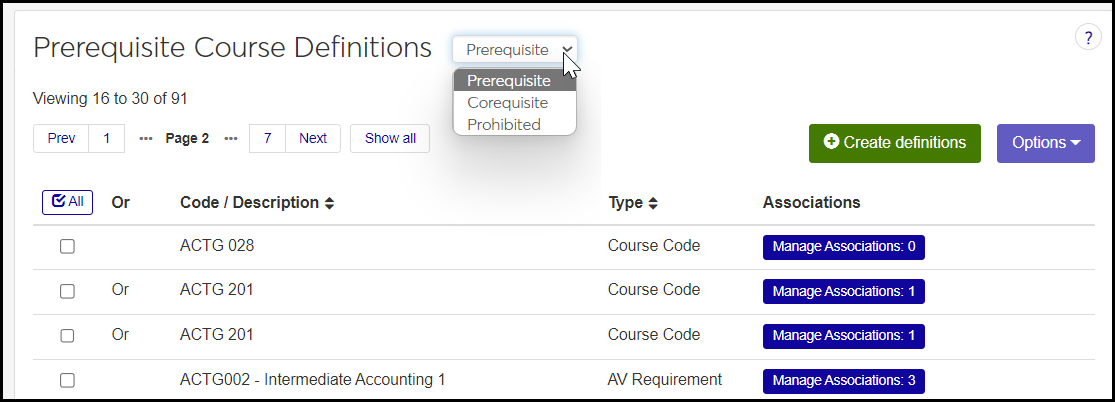
Prerequisites view showing the Manage Associations pop-up
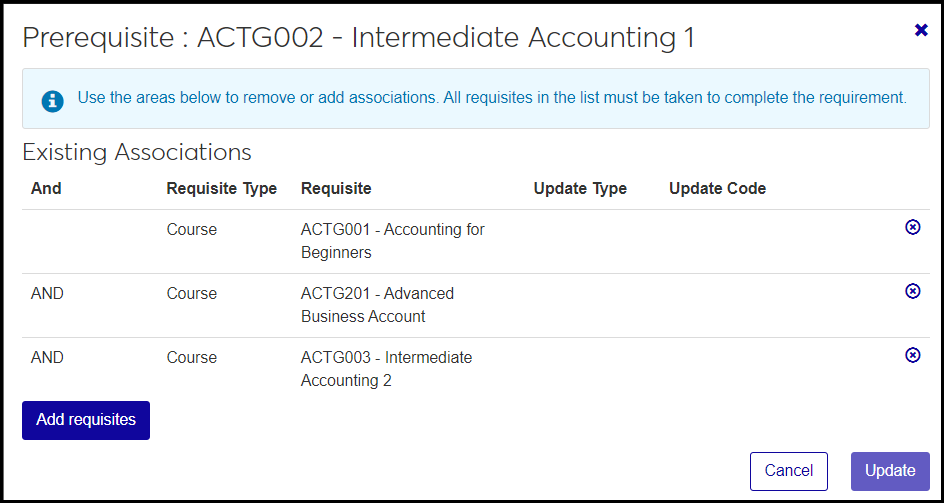
The equivalent window in Desktop is the Prerequisite, Corequisite, and Prohibited Courses window. However, the Desktop window is not available if your school is using J1 Web.
Requisite courses are stored in both a control and a detail table.
Control (prereq_control) and Prerequisite Table (prereq_table)
Corequisite Control (coreq_control) and Corequisite Table (coreq_table)
Prohibited Control (prohibited_control) and Prohibited Table (prohibited_table)
Requisite advising requirements are stored in the following tables:
Prerequisite Advising Control (prereq_adv_control) and Prerequisite Advising Table (prereq_adv_table)
Corequisite Advising Control (coreq_adv_control) and Corequisite Advising Table (coreq_adv_table
Prohibited Advising Control (prohb_adv_control) and Prohibited Advising Table (prohb_adv_table)
You can assign a course one or more prerequisites, and some can be alternatives.
You want Art 480 to have one prerequisite: Art 324. So on the Prerequisites view, you create a definition for Art 480. Then in Manage Associations for Art 480, you add the requisite Art 324.

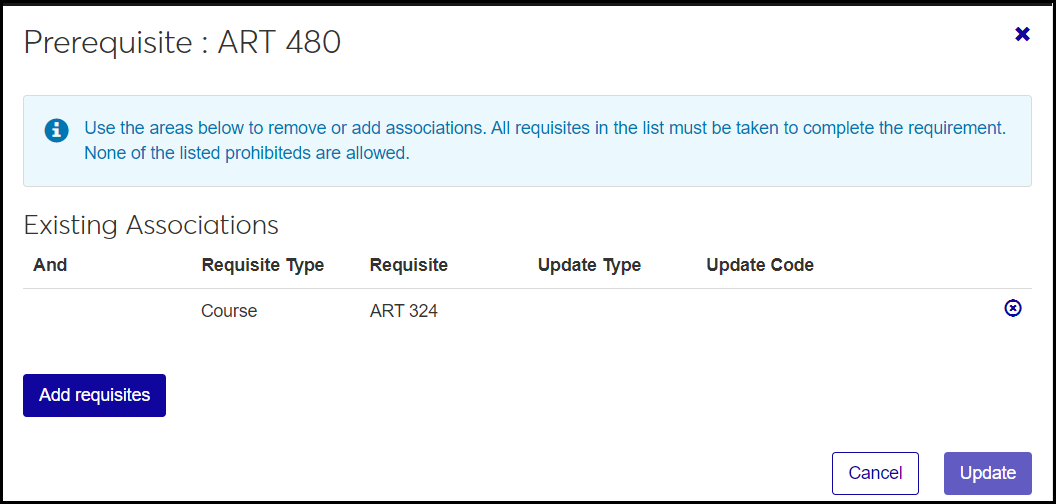
When students register for Art 480, the system will check whether they've successfully completed Art 324.
Tip
Reminder: If the setting for including in-progress courses is selected, then it checks for in-progress or successfully completed Art 324. See the Settings section above.
The Prerequisite Control table captures this as COURSE: ART480, SQ#01.
SQ#01 means "Sequence 1"—the first definition for the system to check. (In this case, it's the only definition.)
The Prerequisite Table captures it as COURSE: ART480, SQ# 01, PREREQ COURSE: ART324.
You want Art 480 to have two prerequisites that are both required: Art 101 AND Art 324. So on the Prerequisites view, you create a definition for Art 480. Then in Manage Associations for Art 480, you add two requisites: Art 101 and Art 324.


When students register for Art 480, the system will check whether they've successfully completed both Art 101 and Art 324.
The Prerequisite Control table (master) has one row: COURSE: Art 480, SQ# 01.
SQ#01 means "Sequence 1"—the first definition for the system to check. (In this case, as in Example 1, it's the only definition.)
The Prerequisite Table (detail) has two entries:
COURSE: ART480, SQ#01, PREREQ COURSE: ART101
COURSE: ART480, SQ#01, PREREQ COURSE: ART324
You want Art 480 to require either of two prerequisites: Art 101 or Art 324. To give students that choice of alternatives, you'll create two prerequisite definitions for Art 480.
Create the first definition, and in its Manage Associations, you add one requisite: Art 101. Next, create the second definition, and in its Manage Associations, add one requisite: Art 324. Now there are two Art 480 definitions, and the second is an Or.

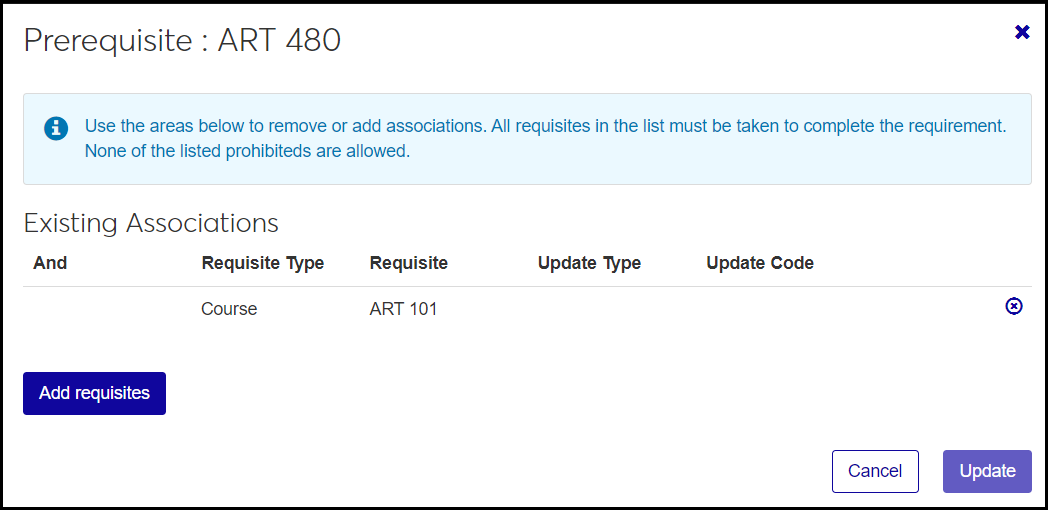
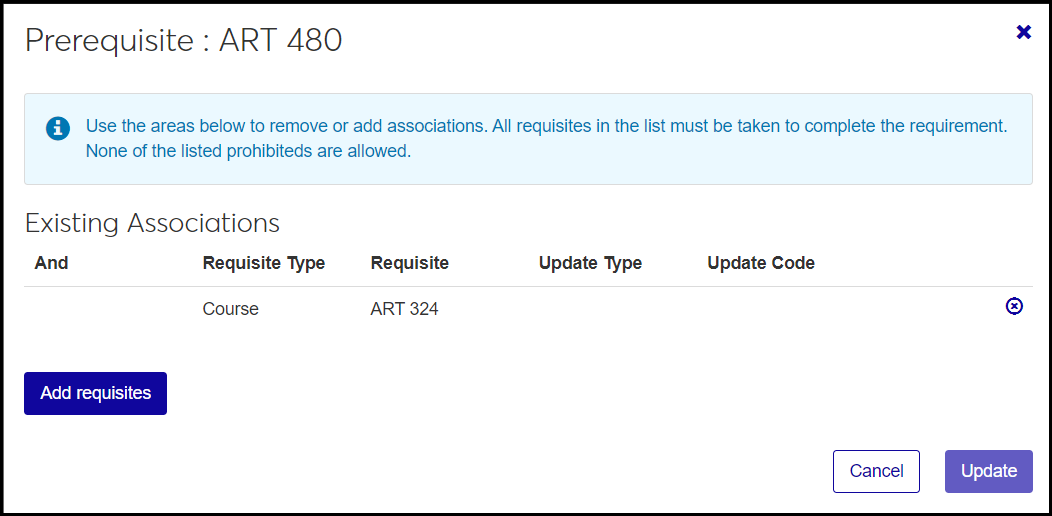
When students register for Art 480, the system will check whether they've successfully completed either Art 101 or Art 324.
The Prerequisite Control table captures two entries:
COURSE: ART480, SQ#: 01 (Sequence 1 is the first definition.)
COURSE: ART480, SQ#: 02 (Sequence 2 is the second definition.)
The Prerequisite Table (detail) also contains two rows:
COURSE: ART480, SQ#: 01, PREREQ COURSE: ART101
COURSE: ART480, SQ#: 02, PREREQ COURSE: ART324
You want Art 480 to require both Art 101 and Art 102, plus a choice of either Art 308 or Art 324. So, as in Example 3, you'll make 2 definitions of prerequisites for Art 480 to handle the choices.
In Manage Associations for the first definition, add Art 101, Art 102, and Art 308 as requisites. In the Manage Associations for the second definition, add Art 101, Art 102, and Art 324 as requisites.

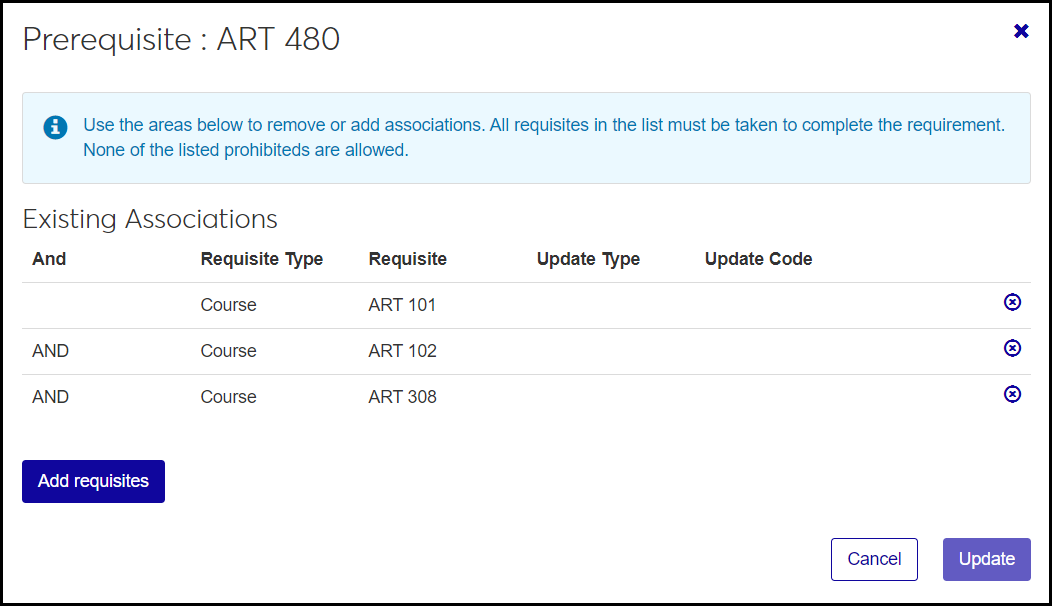
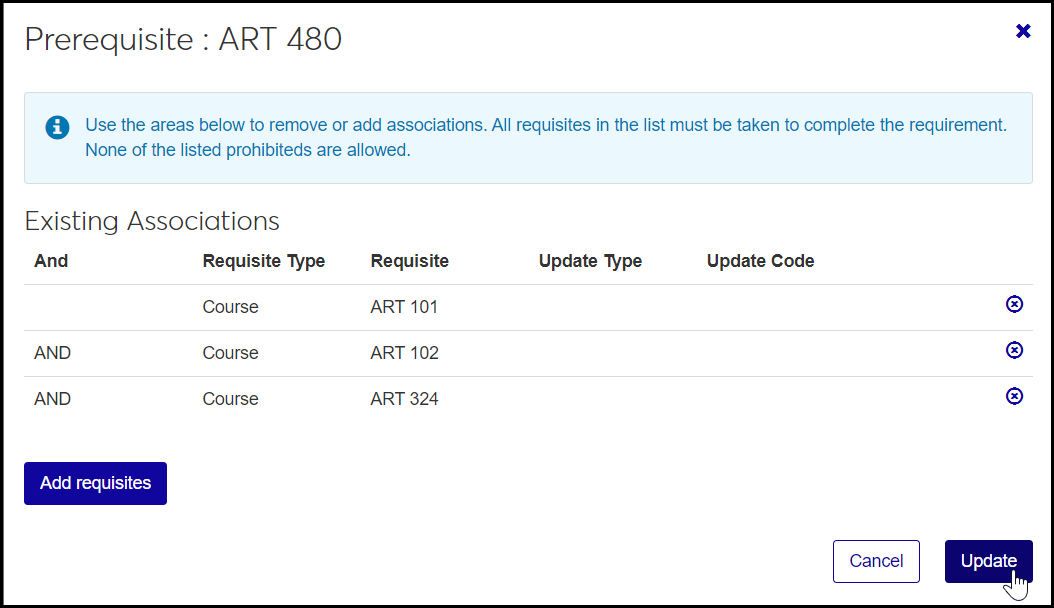
When students register for Art 480, the system will check whether they've completed one of those definitions successfully. In other words, it will check whether they've successfully completed both Art 101 and Art 102 plus either Art 308 or Art 324.
The Prerequisite Control table captures two entries:
COURSE: ART480, SQ#: 01 (Sequence 1 is the first definition.)
COURSE: ART480, SQ#: 02 (Sequence 2 is the second definition.)
The Prerequisite Table (detail) contains six rows:
COURSE: ART480, SQ#: 01, PREREQ COURSE: ART101
COURSE: ART480, SQ#: 02, PREREQ COURSE: ART324
Corequisites work much like prerequisites, but because the associated courses are taken simultaneously, you need to create definitions for both.
The examples in the Prerequisites section above would work for corequisites, too.
You want Art 324 and Art 480 to be corequisites. So on the Corequisites view, you first create a definition for Art 324. In its Manage Associations pop-up, you add the requisite Art 480. Then you create a definition for Art 480, and in its Manage Associations pop-up, you add Art 324.


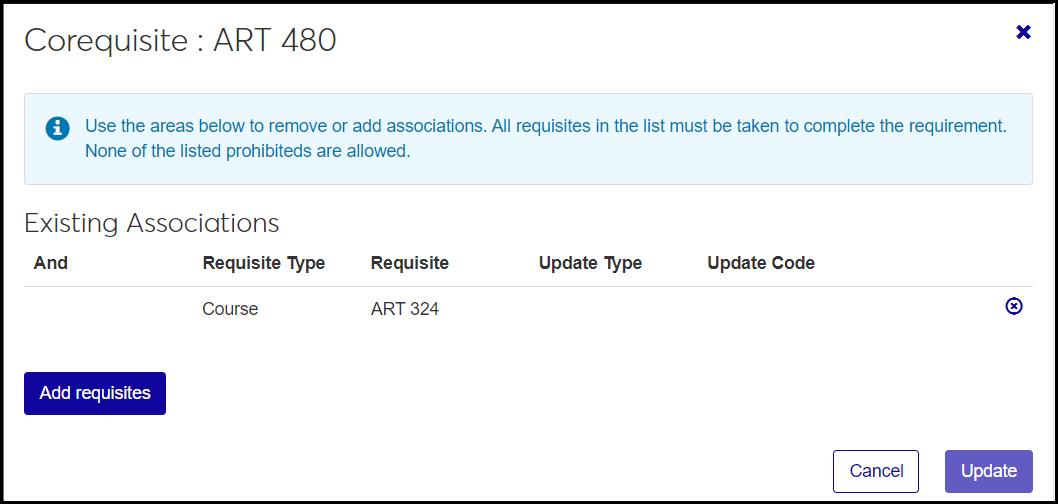
When students register for Art 480, the system will check whether they're also registered for Art 324. And when they register for Art 324, it checks for whether they're also registered for Art 480.
Note
In Oklahoma state reporting, a course is marked as a corequisite only if both of the following conditions are met:
The course is marked as a corequisite here on the Corequisite Course Definitions page.
The course is marked as a Developmental Section on the Student Section Record page, Section Info tab.
Tip
Reminder: If the setting for including previous terms in coreq checking is selected, then it checks for either previously completed or currently registered coreqs.
The Prerequisite Control table captures this as the following:
COURSE: ART324, SQ#01
COURSE: ART480, SQ#01
The Prerequisite Table captures it as follows:
COURSE: ART324, SQ# 01, PREREQ COURSE: ART480
COURSE: ART480, SQ# 01, PREREQ COURSE: ART324
You want to require students taking any of the following courses to take at least two of them simultaneously: Art 305, Art 306, Art 307. You'll create a total of 6 definitions; that is, 2 for each course.
Art 305:
Definition 1's associations: Art 306
Definition 2's associations: Art 307
Art 306:
Definition 1's associations: Art 305
Definition 2's associations: Art 307
Art 307:
Definition 1's associations: Art 305
Definition 2's associations: Art 306
For each course, the second definition is an Or.
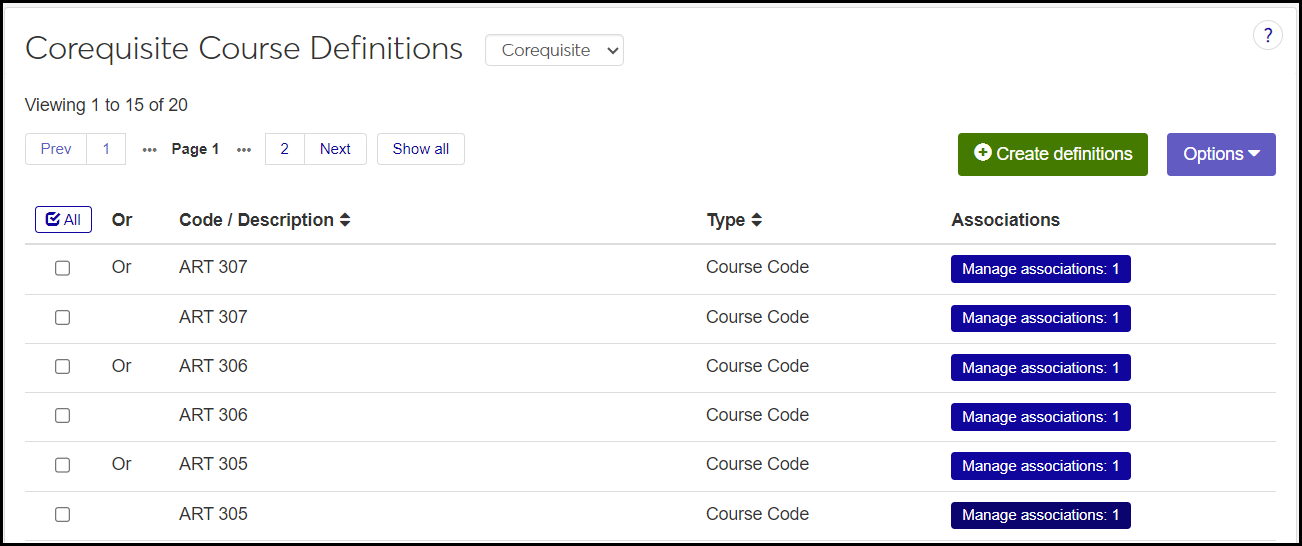
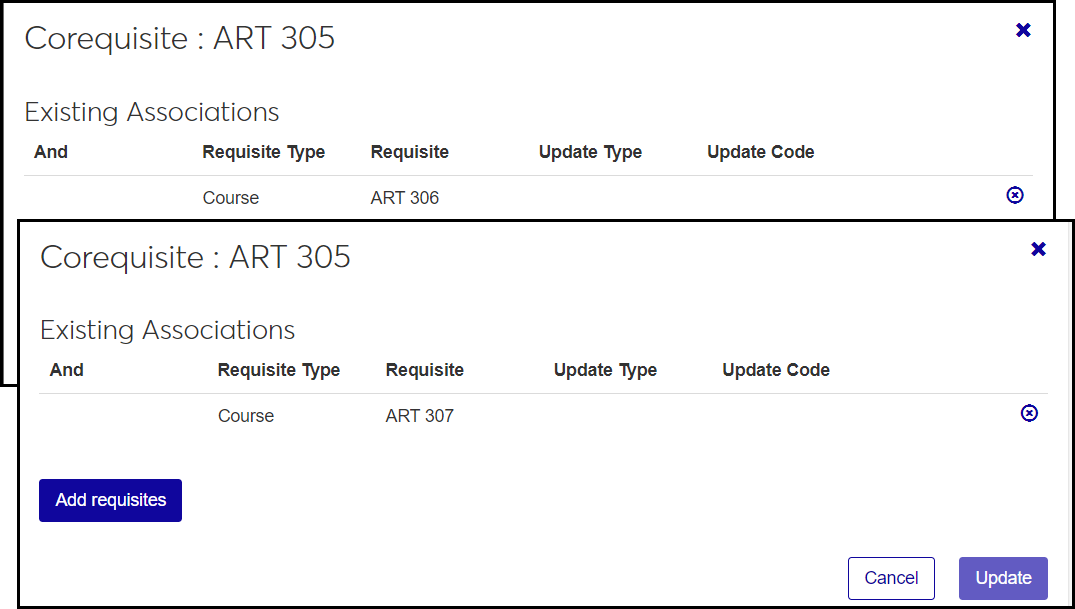
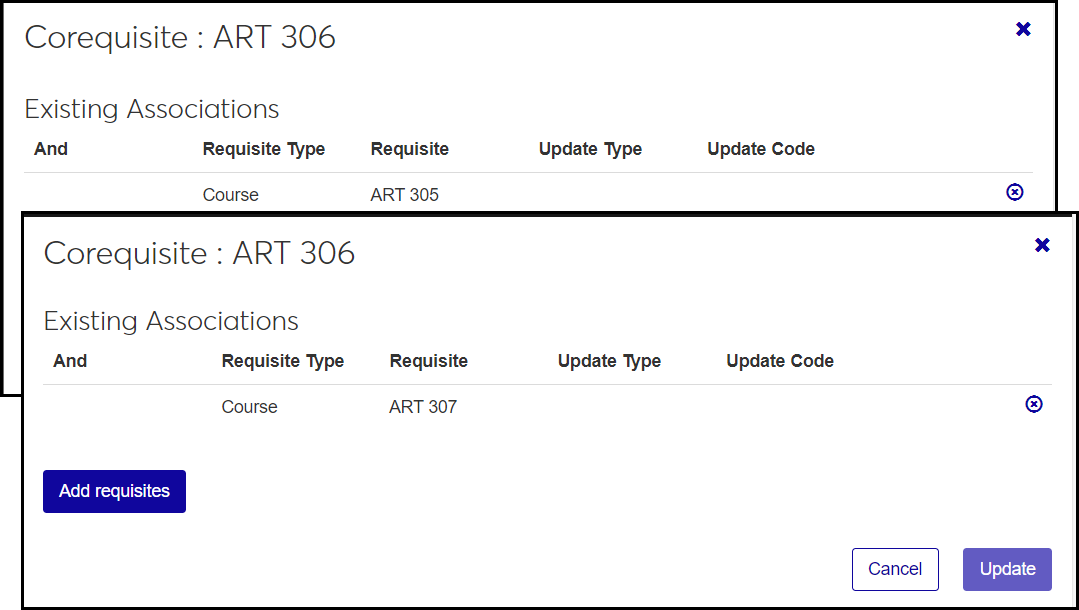
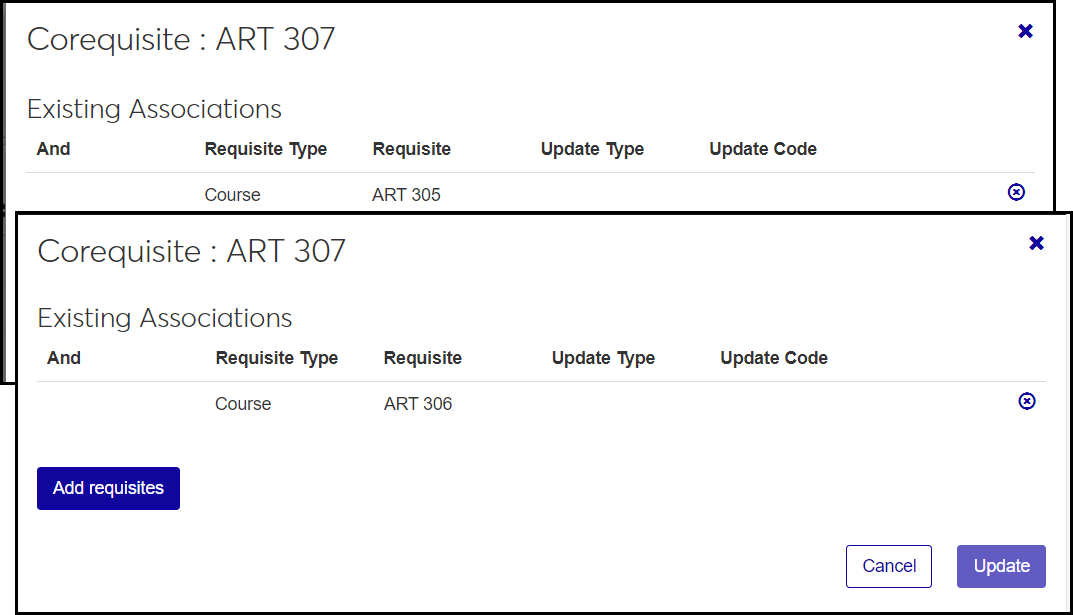
When students register for any of the 3, the system checks whether they're also registered for at least one of the other 2.
The Corequisite Control table captures two entries for each course
COURSE: ART305, SQ#: 01
COURSE: ART305, SQ#: 02
COURSE: ART306, SQ#: 01
COURSE: ART306, SQ#: 02
COURSE: ART307, SQ#: 01
COURSE: ART307, SQ#: 02
The Corequisite Table (detail) also contains two rows for each course:
COURSE: ART305, SQ#: 01, PREREQ COURSE: ART306
COURSE: ART305, SQ#: 02, PREREQ COURSE: ART307
COURSE: ART306, SQ#: 01, PREREQ COURSE: ART305
COURSE: ART306, SQ#: 02, PREREQ COURSE: ART307
COURSE: ART307, SQ#: 01, PREREQ COURSE: ART305
COURSE: ART307, SQ#: 02, PREREQ COURSE: ART306
Each course in a prohibited course set needs its own definition. That is, all corresponding courses need an entry because they are mutually exclusive.
You don't want students to be able to get credit for both Art 305 and Art 306. So in the Prohibited Courses view, you create a definition for Art 305. In its Associations pop-up, you add Art 306.
Then you create a Prohibited definition for Art 306. In its Associations pop-up, you add Art 305.

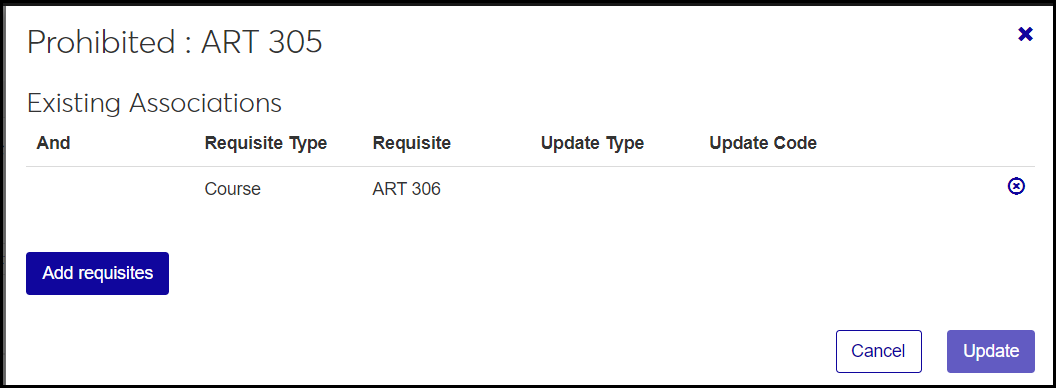
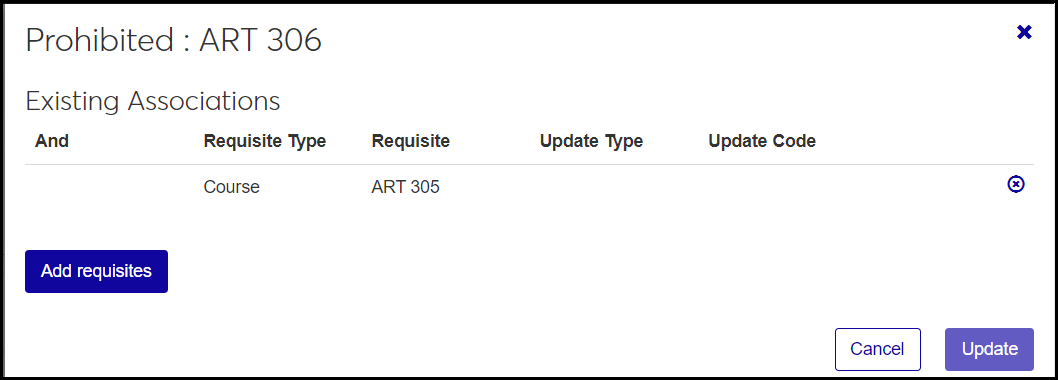
When students register for either Art 305 or Art 306, the system checks to see whether they've already successfully completed or are registered for the other.
The Prohibited Control table captures this as the following:
COURSE: ART305, SQ#01
COURSE: ART306, SQ#01
The Prohibited Table captures it as the following:
COURSE: ART305, SQ# 01, PROHB COURSE: ART306
COURSE: ART306, SQ# 01, PROHB COURSE: ART305
Cross-Listed Courses
Cross-listed courses are a typical example of probiteds. For example, SOC 115 Statistics for Sociology is a cross-listing of Math 110 Introduction to Statistics. They're identical courses listed in two departments. The school creates a prohibited definition for each one with the other as the associated course.
You want students to be able to get credit for only one of the following: Art 305, Art 306, or Art 307. So in the Prohibited Courses view, you create 3 definitions: one for each of the courses. In each definition's Associations pop-up, you add both of the other courses.

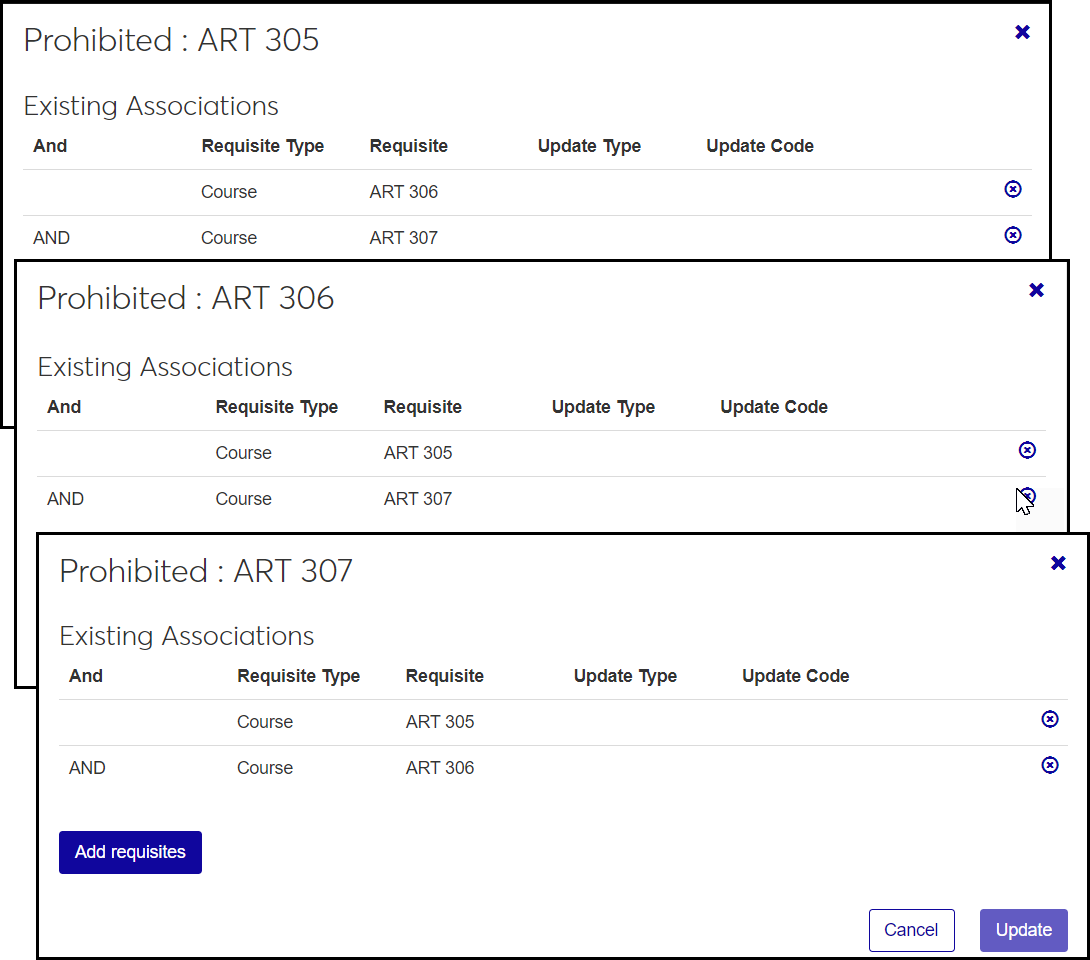
When students register for any of the three, the system checks to see whether they've already successfully completed or are registered for any of the other two.
The Prohibited Control table (master) has three rows:
COURSE: ART305, SQ# 01
COURSE: ART306, SQ# 01
COURSE: ART307, SQ# 01
The Prohibited Table (detail) has six entries:
COURSE: ART305, SQ#01, PROHB COURSE: ART306
COURSE: ART305, SQ#01, PROHB COURSE: ART307
COURSE: ART306, SQ#01, PROHB COURSE: ART305
COURSE: ART306, SQ#02, PROHB COURSE: ART307
COURSE: ART307, SQ#01, PROHB COURSE: ART305
COURSE: ART307, SQ#02, PROHB COURSE: ART306
You want students to be able to get credit for any two of Art 305, 306, and 307. So you create two definitions for each course. In the first definition, you associate the second course as prohibited. In the second definition, you associate the third course as prohibited.
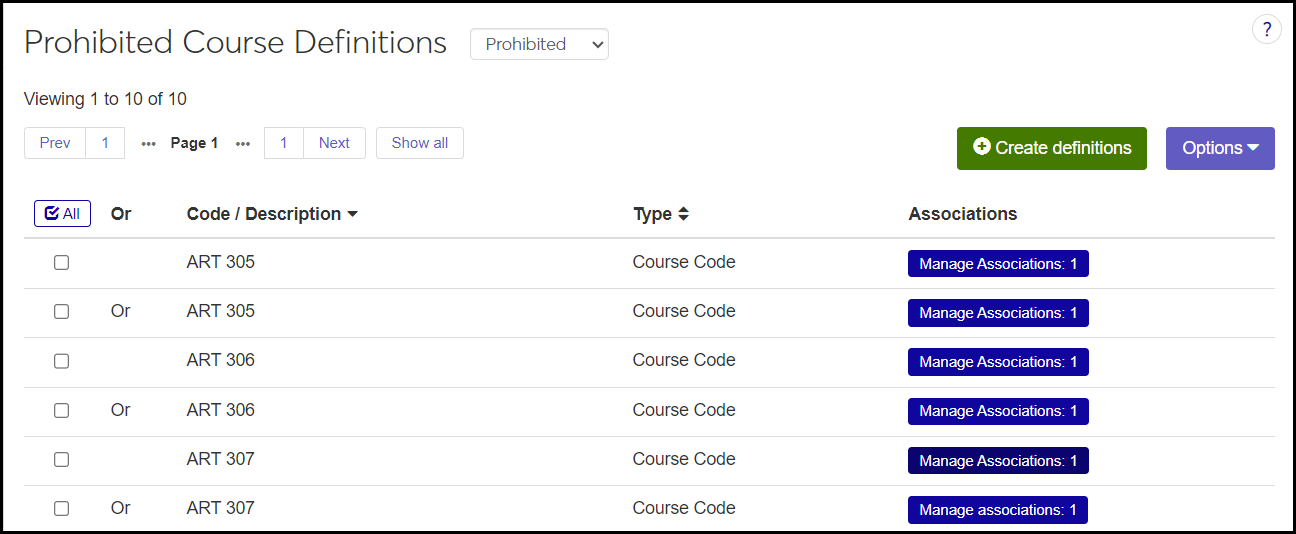
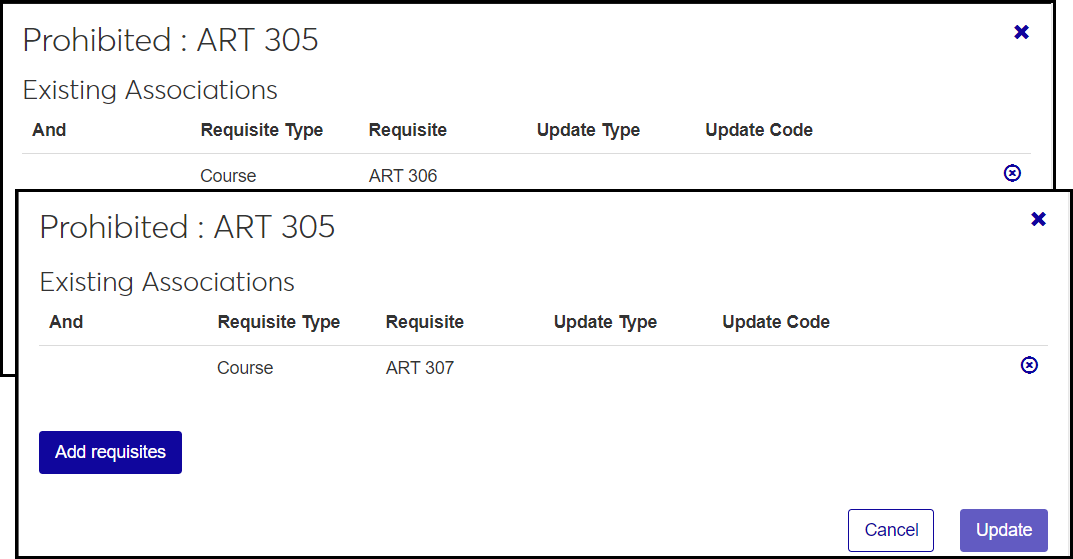
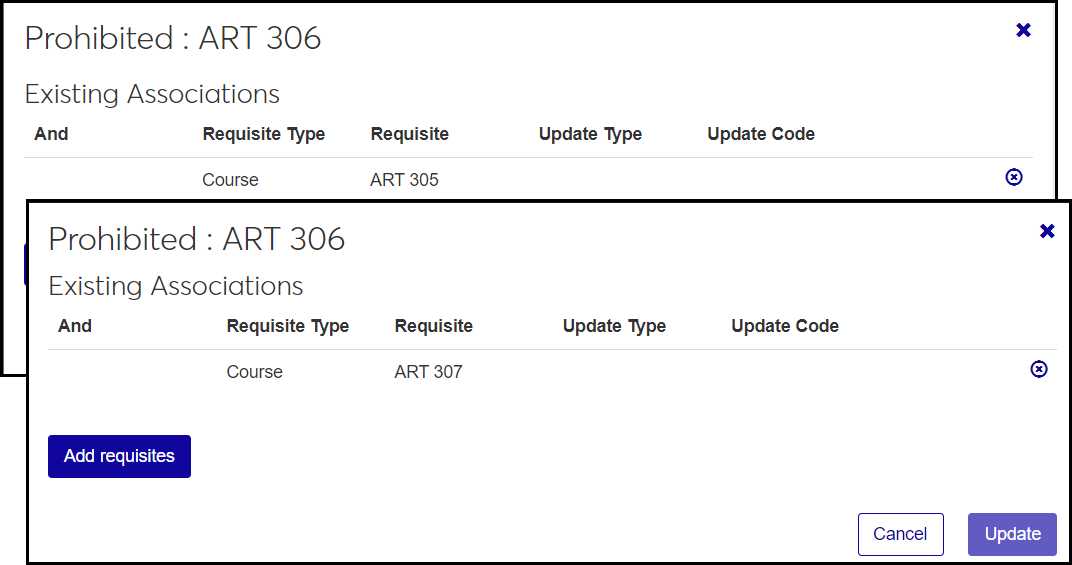
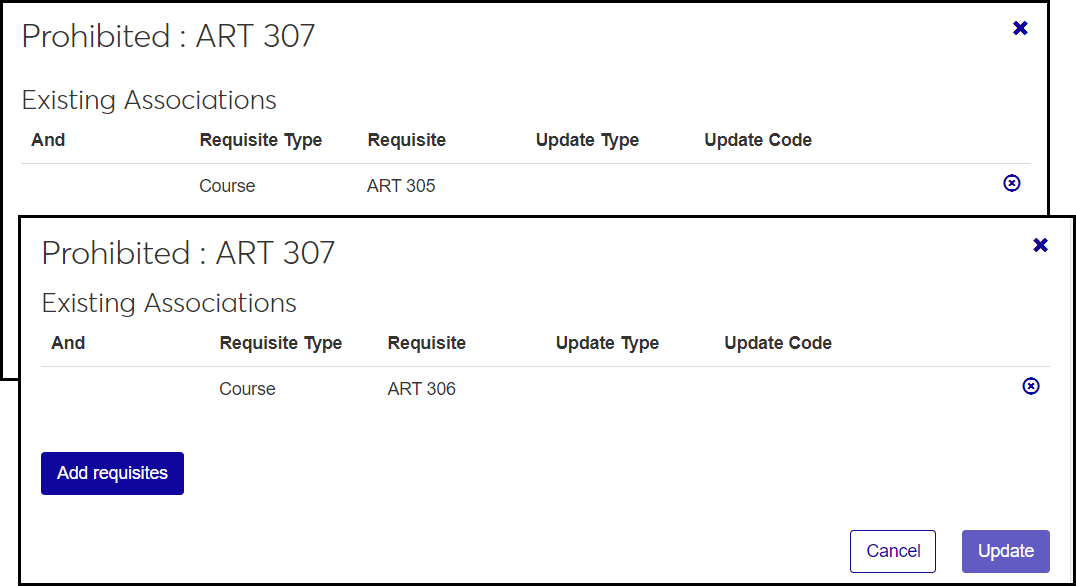
When students register for any of the three, the system checks to see whether they've already successfully completed or are registered for the other two. It inhibits registration only if it finds both of the others.
The Prohibited Control table captures two entries for each course:
COURSE: ART305, SQ# 01
COURSE: ART305, SQ# 02
COURSE: ART306, SQ# 01
COURSE: ART306, SQ# 02
COURSE: ART307, SQ# 01
COURSE: ART307, SQ# 02
The Prohibited Table (detail) also contains two rows for each course:
COURSE: ART305, SQ#: 01, PROHB COURSE: ART306
COURSE: ART305, SQ#: 02, PROHB COURSE: ART307
COURSE: ART306, SQ#: 01, PROHB COURSE: ART305
COURSE: ART306, SQ#: 02, PROHB COURSE: ART307
COURSE: ART307, SQ#: 01, PROHB COURSE: ART305
COURSE: ART307, SQ#: 02, PROHB COURSE: ART306
The following permissions, found in the Manage Requisite Definitions category of both the Registrars role and the Registration Module Manager role (and roles copied from them), apply to prerequisites, corequisites, and prohibiteds.
Can view prerequisite course definitions
Can manage preqrequisite course definitions
Can view corequisite course definitions
Can manage corequisite course definitions
Can view prohibited course definitions
Can manage prohibited course definitions
From the Registration Administration hub, click Hub options > Requisites.
Select one of the options:
Prerequisite Course Definitions
Corequisite Course Definitions
Prohibited Course Definitions
The page opens. Use the filter to narrow the list as necessary.
For examples and methods, see each section above for Prerequisite, Corequisite, and Prohibited Courses. The steps below are details of the mechanics of making and removing associations.
On a definition's row, click the Manage Associations button. The Associations pop-up opens.
To remove a requisite or prohibited course, click the Remove
 icon.
icon.To add a requisite or prohibited course, click the Add requisites button. The Add pop-up opens.
In Requisite Type, select either Course or Noncourse.
For Noncourse, enter the Update Code. Update Codes come from Rules Based Update, so this is for schools using RBU to create complex requirements.
For Course, enter the Department and Course Number. (Section and Lab are optional.)
Click Update. The Add pop-up closes. The new requisite appears in the Existing Associations list.
Click the Update button. The Associations pop-up closes, and your changes are saved.
Click the Create definitions button. The Create pop-up opens.
Select the Requisite Type: Advising Requirement or Course Code. (For Prohibited Courses, only Course Code is available.)
Tip
The type you select here is the only type that appears in drop-downs for this definition.
For Advising Requirements, select a Code / Description.
For Course Codes, select a Department and Course Number. (For Corequisites and Prohibited Courses, you can also select a Section and Lab.)
Click either Save and create another or Create and close.
Select the checkboxes next to the rows you want to export.
From the Options drop-down, select Download to Excel. The Download to Excel pop-up opens.
Select options for the Excel format and data columns.
Click Download. Your .xlsx or .zip file is saved in the file location that you have set in your browser settings.